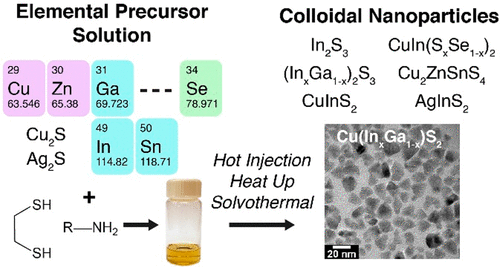当前位置:
X-MOL 学术
›
Chem. Mater.
›
论文详情
Our official English website, www.x-mol.net, welcomes your
feedback! (Note: you will need to create a separate account there.)
Versatile Colloidal Syntheses of Metal Chalcogenide Nanoparticles from Elemental Precursors Using Amine-Thiol Chemistry
Chemistry of Materials ( IF 7.2 ) Pub Date : 2019-11-01 , DOI: 10.1021/acs.chemmater.9b03401
Swapnil D. Deshmukh 1 , Ryan G. Ellis 1 , Dwi S. Sutandar 1 , David J. Rokke 1 , Rakesh Agrawal 1
Chemistry of Materials ( IF 7.2 ) Pub Date : 2019-11-01 , DOI: 10.1021/acs.chemmater.9b03401
Swapnil D. Deshmukh 1 , Ryan G. Ellis 1 , Dwi S. Sutandar 1 , David J. Rokke 1 , Rakesh Agrawal 1
Affiliation

|
Colloidal metal chalcogenide nanoparticles have emerged as a promising hydrazine-free route for the fabrication of solution processed electronic devices. While a wide variety of synthetic pathways have been developed for these nanomaterials, typical colloidal syntheses rely on the use of metal salts as precursors, which contain anionic impurities such as halides, nitrates, acetates, and so forth, that may incorporate and alter the electrical properties of the targeted nanoparticles. In this report, the recent advances in amine-thiol chemistry and its unique ability to dissolve pure metals, chalcogens, and metal chalcogenides is expanded upon for the fabrication of metal chalcogenide nanoparticles. Alkylammonium metal thiolate species are easily formed upon addition of monoamine and dithiol to elemental Cu, In, Ga, Sn, Zn, Se, or metal chalcogenides such as Cu2S and Ag2S. These species were then used directly for the synthesis of colloidal nanoparticles without the need for any additional purification. The thermal decomposition pathway of one such representative alkylammonium metal thiolate species was studied, verifying that only metal chalcogenides and volatile byproducts are formed, providing a flexible route to compositionally uniform, phase pure, and anionic impurity-free colloidal nanoparticles. Synthetic methods were developed from these precursors to yield pure phase colloidal nanoparticles of binary, ternary, and quaternary materials and their alloys including In2S3, (InxGa1–x)2S3, CuInS2, CuIn(SxSe1–x)2, Cu(InxGa1–x)S2, Cu2ZnSnS4, and AgInS2. Successful synthesis with various experimental methods such as heat up, hot injection, and microwave assisted solvothermal reactions were also demonstrated, showing the flexibility and greater scope for this new synthesis route.
中文翻译:

使用胺-硫醇化学从元素前体中金属硫属元素化物纳米粒子的通用胶体合成
胶态金属硫族化物纳米粒子已成为一种有前途的无肼途径,可用于溶液加工的电子设备的制造。尽管已经为这些纳米材料开发了各种各样的合成途径,但是典型的胶体合成依赖于使用金属盐作为前体,其中金属盐包含阴离子杂质,例如卤化物,硝酸盐,乙酸盐等,这些杂质可能会掺入并改变电学性质。目标纳米粒子的性质。在本报告中,胺硫醇化学的最新进展及其溶解纯金属,硫属元素化物和金属硫属元素化物的独特能力被扩展到金属硫属元素化物纳米粒子的制造中。将单胺和二硫醇添加到元素Cu,In,Ga,Sn,Zn,Se,2个S和的Ag 2 S.这些物种然后直接用于胶体纳米粒子的合成,而不需要任何额外的纯化。研究了一种这样的代表性烷基铵金属硫醇盐物种的热分解途径,验证了仅形成金属硫属元素化物和挥发性副产物,为组成均匀,相纯和无阴离子杂质的胶体纳米粒子提供了灵活的途径。从这些前体开发了合成方法,以生成二元,三元和四元材料及其合金(包括In 2 S 3,(In x Ga 1– x)2 S 3)的纯相胶体纳米颗粒。,CuInS 2,CuIn(S x Se 1– x)2,Cu(In x Ga 1– x)S 2,Cu 2 ZnSnS 4和AgInS 2。还展示了通过各种实验方法(例如加热,热注射和微波辅助溶剂热反应)成功合成的结果,显示出这种新合成路线的灵活性和更大的应用范围。
更新日期:2019-11-01
中文翻译:

使用胺-硫醇化学从元素前体中金属硫属元素化物纳米粒子的通用胶体合成
胶态金属硫族化物纳米粒子已成为一种有前途的无肼途径,可用于溶液加工的电子设备的制造。尽管已经为这些纳米材料开发了各种各样的合成途径,但是典型的胶体合成依赖于使用金属盐作为前体,其中金属盐包含阴离子杂质,例如卤化物,硝酸盐,乙酸盐等,这些杂质可能会掺入并改变电学性质。目标纳米粒子的性质。在本报告中,胺硫醇化学的最新进展及其溶解纯金属,硫属元素化物和金属硫属元素化物的独特能力被扩展到金属硫属元素化物纳米粒子的制造中。将单胺和二硫醇添加到元素Cu,In,Ga,Sn,Zn,Se,2个S和的Ag 2 S.这些物种然后直接用于胶体纳米粒子的合成,而不需要任何额外的纯化。研究了一种这样的代表性烷基铵金属硫醇盐物种的热分解途径,验证了仅形成金属硫属元素化物和挥发性副产物,为组成均匀,相纯和无阴离子杂质的胶体纳米粒子提供了灵活的途径。从这些前体开发了合成方法,以生成二元,三元和四元材料及其合金(包括In 2 S 3,(In x Ga 1– x)2 S 3)的纯相胶体纳米颗粒。,CuInS 2,CuIn(S x Se 1– x)2,Cu(In x Ga 1– x)S 2,Cu 2 ZnSnS 4和AgInS 2。还展示了通过各种实验方法(例如加热,热注射和微波辅助溶剂热反应)成功合成的结果,显示出这种新合成路线的灵活性和更大的应用范围。































 京公网安备 11010802027423号
京公网安备 11010802027423号